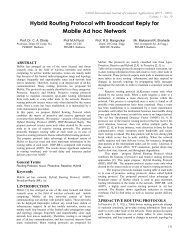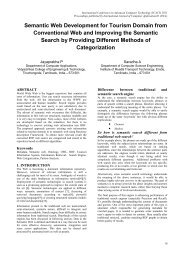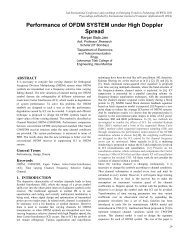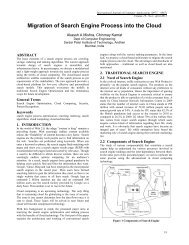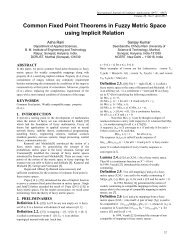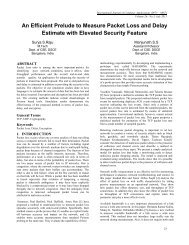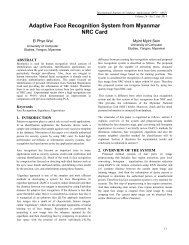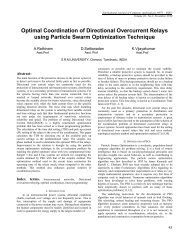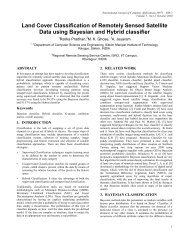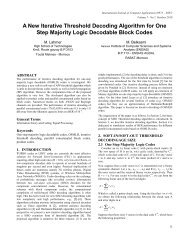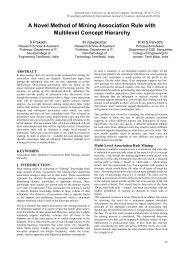Ontology Modeling Profile, an Extension for the ... - ResearchGate
Ontology Modeling Profile, an Extension for the ... - ResearchGate
Ontology Modeling Profile, an Extension for the ... - ResearchGate
You also want an ePaper? Increase the reach of your titles
YUMPU automatically turns print PDFs into web optimized ePapers that Google loves.
International Journal of Computer Applications (0975 – 8887)<br />
Volume 6– No.12, September 2010<br />
Figure 13: Individual from <strong>the</strong> Museum Class Diagram.<br />
Figure 11:DatatypeProperties from <strong>the</strong> Museum Class<br />
Diagram .<br />
Unlike datatypeProperties, object properties are connected with<br />
<strong>the</strong>ir domains <strong>an</strong>d r<strong>an</strong>ges, using associations stereotyped<br />
<strong>an</strong>d respectively, as shown in Figure 12.<br />
Figure 12:ObjectProperties from <strong>the</strong> Museum Class<br />
Diagram.<br />
Individuals in OWL represent inst<strong>an</strong>ces of owl:classes. They are<br />
ei<strong>the</strong>r subject or object as shown in <strong>the</strong> Figure 13. Object<br />
properties inst<strong>an</strong>ces are predicates(if <strong>the</strong>y participate in a<br />
statement) that connect subject with object.<br />
Note that in our approach data type properties do not participate<br />
as a part in <strong>the</strong> OWL statement constructions. They are used to<br />
fill in <strong>the</strong> slots value of owl class. For example, <strong>the</strong> inst<strong>an</strong>ce of<br />
owl:class painting named Autoportrait has 2 data type slots, one<br />
is title which was given <strong>the</strong> value of <strong>an</strong> inst<strong>an</strong>ce of a data type<br />
Property class named AutoportraitTile , <strong>an</strong>d <strong>the</strong> second is year<br />
which was given a value of <strong>the</strong> inst<strong>an</strong>ce of data type property<br />
named year as shown in Figure 13.<br />
For more clarifying lets take <strong>the</strong> statement as <strong>an</strong> example. Using Individuals it will be interpreted<br />
as . For subject slot, <strong>the</strong><br />
navigable link stereotyped between <strong>the</strong> subject<br />
Pablo Picasso Painter has <strong>an</strong> association end property referring to<br />
<strong>the</strong> subject of <strong>the</strong> statement, which is Pablo Picasso. We<br />
stereotyped this owned end property with . The<br />
object slot is not owned by <strong>the</strong> link, ra<strong>the</strong>r, it was owned by <strong>the</strong><br />
predicate, in this case Paints. This slot that has <strong>the</strong> same type as<br />
<strong>the</strong> object , which is <strong>the</strong> painting Autoportrait is stereotyped<br />
.<br />
7. CONCLUSION<br />
The <strong>Ontology</strong> <strong>Modeling</strong> <strong>Profile</strong>, that was extended from <strong>the</strong><br />
OUP, toge<strong>the</strong>r with ODM are in accord<strong>an</strong>ce with <strong>the</strong> OMG’s<br />
RFP initiative <strong>for</strong> ontology modeling. We concern <strong>the</strong> individual<br />
modeling with statement constructing elements. This profile<br />
enables using ontologies in <strong>the</strong> way that is closer to software<br />
engineering practitioners. Also, since <strong>the</strong> UML <strong>an</strong>d ODM are<br />
defined as MOF-compli<strong>an</strong>t l<strong>an</strong>guages it is possible to store<br />
ontologies in MOF-based repositories, to store ontology diagrams<br />
in a st<strong>an</strong>dard way (UML2 XMI), as well as to share <strong>an</strong>d<br />
interch<strong>an</strong>ge ontologies using XMI. With <strong>the</strong> <strong>Ontology</strong> UML<br />
<strong>Profile</strong>, <strong>the</strong> ODM concepts c<strong>an</strong> be used as stereotypes in <strong>the</strong><br />
UML models.<br />
A practical implementation <strong>for</strong> mapping between <strong>Ontology</strong><br />
model <strong>an</strong>d Requirement model will be carried out using <strong>the</strong><br />
OMP to show how this profile was able to converge between<br />
MDA st<strong>an</strong>dards <strong>an</strong>d <strong>the</strong> Web <strong>Ontology</strong> L<strong>an</strong>guage. We pl<strong>an</strong> to<br />
extract <strong>the</strong> requirement <strong>an</strong>alysis model from <strong>the</strong> domain model<br />
(ontology), accordingly we aim to use model tr<strong>an</strong>s<strong>for</strong>mation from<br />
<strong>the</strong> <strong>Ontology</strong> Model (OM) to <strong>the</strong> Requirement Analysis Model<br />
(RAM). We also aim to make automatic generation of <strong>the</strong> Web<br />
<strong>Ontology</strong> L<strong>an</strong>guage (OWL) from UML model based on our<br />
profile (OMP).This conversion tr<strong>an</strong>s<strong>for</strong>ms <strong>an</strong> ontology from its<br />
OMP into OWL description. Accordingly, this generated OWL<br />
model c<strong>an</strong> be shared with ontological engineering tools (i.e.<br />
Protge).<br />
27



